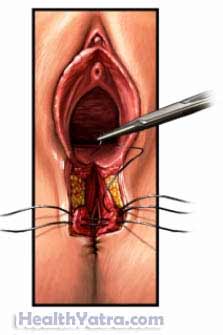परिभाषा
Vaginal lacerations are tears in the vagina or in the skin and muscle around the vaginal opening. Tears most commonly occur in the perineum. The perineum is the area between the anus and the opening of the vagina.
There are four degrees of vaginal laceration:
- First—superficial lacerations of the skin or vagina; often no repair is needed.
- Second—deep laceration involving the skin or vagina and underlying fatty tissue; a simple suture repair is needed.
- Third—deeper laceration involving the muscles of the anus (sphincter); suture repair of the muscle and the vagina is needed.
- Fourth—most extensive laceration involving the entire thickness of the vagina, sphincter, and through the inner lining of the rectum (rectal mucosa); suture repair of the vagina, muscle, and rectal mucosa is needed.
का कारण बनता है
The deeper vaginal lacerations may occur during vaginal delivery. Examples of causes include:
- Delivering a baby whose head is too large to easily fit through the vaginal opening
- Going into labor too quickly (without giving the perineum time to stretch)
- Having a difficult vaginal delivery and needing assistance with forceps or vacuum extraction
Minor lacerations can occur during sexual intercourse.
जोखिम कारक
Tell your doctor if you have any of these risk factors:
- Having a very large baby
- Having a baby for the first time
- Having had lacerations in prior गर्भावस्था
लक्षण
There are usually no symptoms of vaginal laceration.
निदान
Your doctor will be with you during labor and will see any tearing if it happens. The seriousness will be based on the size of the tears and what muscles are affected. If the doctor thinks you may tear during pushing, she may recommend an episiotomy. This is a surgical incision of the perineum. An episiotomy will make the vaginal opening temporarily larger so that the baby does not tear the vagina or the surrounding muscles.
उपचार
Talk with your doctor about the best treatment plan for you. Treatment options:
Suturing
First degree tears are superficial. They often do not require stitches and will heal naturally. Second degree tears are deeper into the tissue, require a few stitches, and then heal well afterward. Third and fourth degree tears require more stitches to be repaired correctly.

घर की देखभाल
Other treatments that can be used at home to lessen the pain of the stitches include:
- Nonsteroidal anti-inflammatory drugs (eg, ibuprofen)
- Warm baths—Sitting in a warm bath that only covers your hips and buttocks can sometimes help; this is called a sitz bath.
- Ice or witch hazel pads—Ice wrapped in a cloth or chilled witch hazel pads applied to the area are sometimes used to dull the pain.
If you have a more serious laceration, your doctor may recommend that you take a stool softener and follow a special diet.
If you are diagnosed with vaginal laceration, follow your doctor’s instructions.
रोकथाम
To help reduce your chance of getting vaginal laceration, take the following steps:
- Perineal massage – You or your partner can begin to massage the perineum with fingers and a lubricating jelly, like K-Y Jelly, when you are about 34 weeks pregnant. After that, it should be done every day. This action will soften and smooth the skin and may help it to stretch more easily during labor.
- Kegel exercises – Contract and hold the muscles of your pelvic floor. These are the same muscles you use to stop the flow of urine. Practice contracting, holding, and slowly releasing these muscles to strengthen them.
- Practice good nutrition—Healthy skin stretches more easily.
- A slow second stage of labor—Controlled pushing allows the perineum to stretch slowly.
